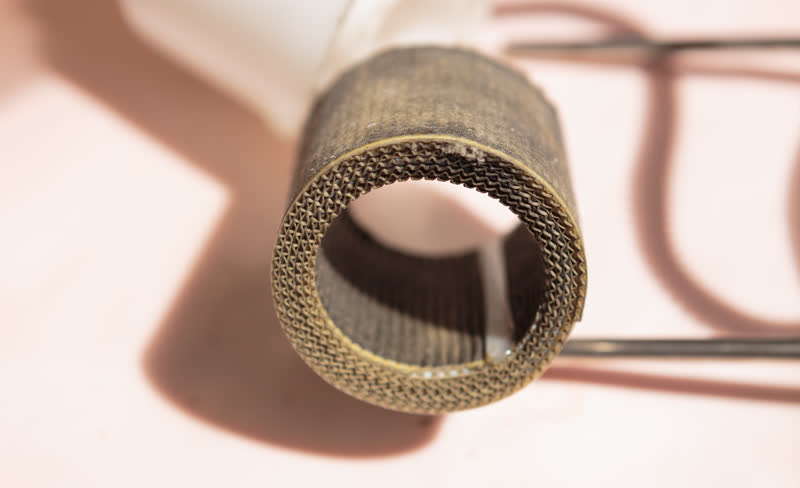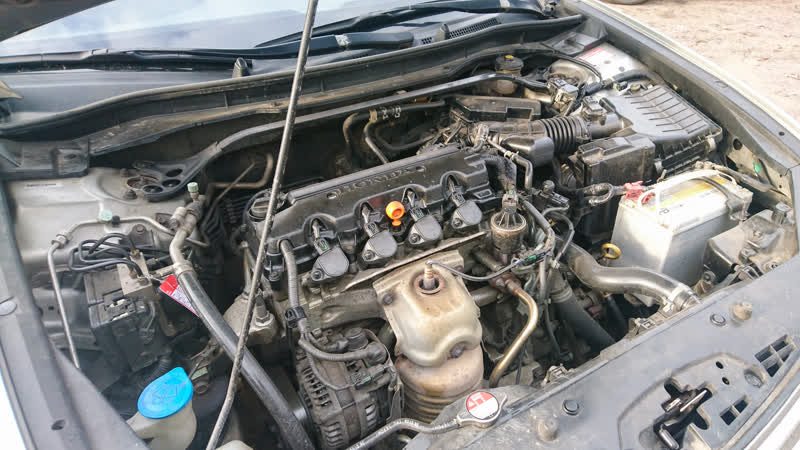It’s been over a year since the last cleaning. The procedure was almost identical:
Clean surfaces from sand, leaves, and bugs with a brush. Disconnect the battery. Wrap sensors, connectors, and the belt with plastic wrap. Protect eyes, nose, and hands. Apply Würth 0890.23 engine cleaning spray. Wait for 10 minutes. Rinse off the product with hot water using a high-pressure washer. Dry the area. Apply Würth 0893.15 corrosion protection spray.
The previous brake pads lasted for 20,850 km, with an estimated 3-4 thousand km remaining before reaching critical wear. Notably, they produced a considerable amount of dust, wore down the disc by less than a millimeter, and emitted a squealing sound as an indication of the need for replacement.
Despite a common trend in Belarus of skipping vehicle inspections:
State duty / 75 USD Permit / 4 USD Technical inspection / 11 USD The CO and CH levels were approximately the same as the last inspection in 2017.
A routine replacement of the fuel filter was carried out. The rear seat cushion was preemptively removed to prevent damage to the hooks at the service station.
Over four years and 59,203 km, the vehicle underwent 138 fuel fill-ups (128 at Gazpromneft stations and 10 at Belorusneft stations), with the filter processing 5,365 liters of AI-98 fuel.
Photos were taken of the markings for comparison with the factory filter.
Out of curiosity about the quality of Gazpromneft’s 98-octane fuel, the old filter was cut open.
Engaged in preventive treatment of seals, connections, hinges, and locks.
Stainless Steel Cleaner and Paste
Primarily acquired for household use, but also applied to all chrome details on the doors, front grille, door handles, and badges. The procedure involved wiping these parts with cloths dampened in the cleaner, followed by a similar application of the paste.
Silicone Spray
Used to maintain the elasticity of door, hood, and trunk seals, roof moldings, door sheaths/hoses, seat guides, seat belt anchor points, and their contact areas with the seats.
The recent service included an oil change and air filter replacement, with the oil level at the upper mark and no top-up needed between changes. The vehicle covered 5,595 km, utilized 520 liters of AI-98 fuel, resulting in fuel efficiency of 10.7 L/100km and 178 motor hours.
Engine oil filter / Honda 15400RTA004 / 8 USD
Drain plug sealing ring / Honda 94109-140-00 / 1 USD
Engine oil / Honda Ultra Leo 0W20 (0821799974, 4L, Japan) / 47 USD
The planning for the 200,000 km service revealed information about a recall campaign concerning the passenger airbag: www.honda.pl/cars/owners/airbag-recall.html
The need for replacement was confirmed by the official dealer in Bialystok. The airbag inflator was ordered, and everything was prepared for the visit within five days.
Before the replacement, the new airbag was shown, and afterward, the old inflator was displayed.
Service Actions for the 200,000 km Maintenance:
Valve adjustment / 44.
The P0171 error code indicates that the fuel-air mixture in your Honda Accord (8th Generation) is too lean, meaning there’s too much air in the mix and not enough fuel. This issue can affect vehicle performance and emissions, and addressing it promptly is important to maintain engine health.
The absence of accompanying error codes focuses the troubleshooting on fuel mixture issues directly. According to Honda’s troubleshooting guidelines for DTCs P0171 and P0172, and considering the conditions under which the measurements were taken (coolant temperature ~90°C, crankshaft RPM ~650, and transmission in Neutral), several factors were reviewed:
Routine maintenance was conducted, with the automatic transmission fluid (ATF) having served for 36,073 km.
Three liters were drained. Prior to the change, the fluid level was slightly below the maximum, with no burn smell and a clean, pink color.
During a car wash, the roof molding on the passenger side was torn off, and one of the fasteners was lost.
One of the license plate illumination bulbs went out. The manufacturer was unknown, installed by the previous owner.
The routine oil and filter replacement data indicate:
6,109 km driven since the last change 165 motor hours 610 liters of AI-98 fuel consumed Fuel efficiency at 10 L/100km Parts replaced and their costs:
Engine oil filter / Honda 15400RTA004 / 12 USD
Drain plug sealing ring / Honda 94109-140-00 / 1 USD
Engine oil / Honda Ultra Leo 0W20 (0821799974, 4L, Japan) / 59 USD
Total cost: 81 USD
The left fog lamp went out. After dismantling the “non-serviceable” housing, it was found that moisture had entered the control unit through the power cable. The driver was repaired, and the lamps worked for another month.
Soon, the left lamp failed again, this time taking a 10A fuse (driver’s side No. 26) with it. Moisture was again the culprit, causing almost everything inside the block to burn out.
The same type of lamps was ordered.









